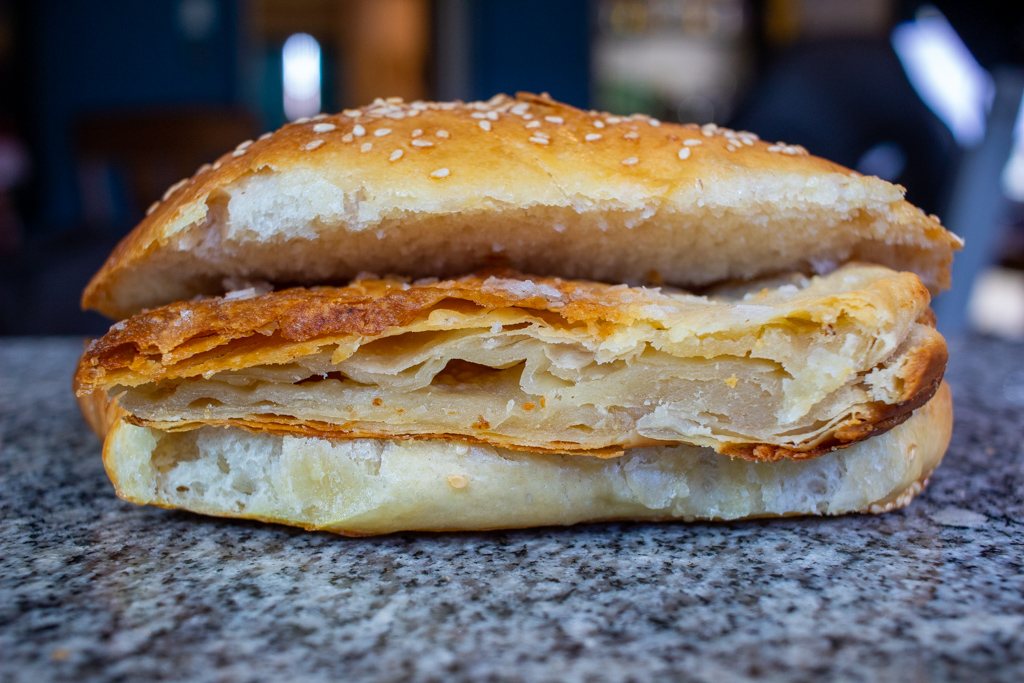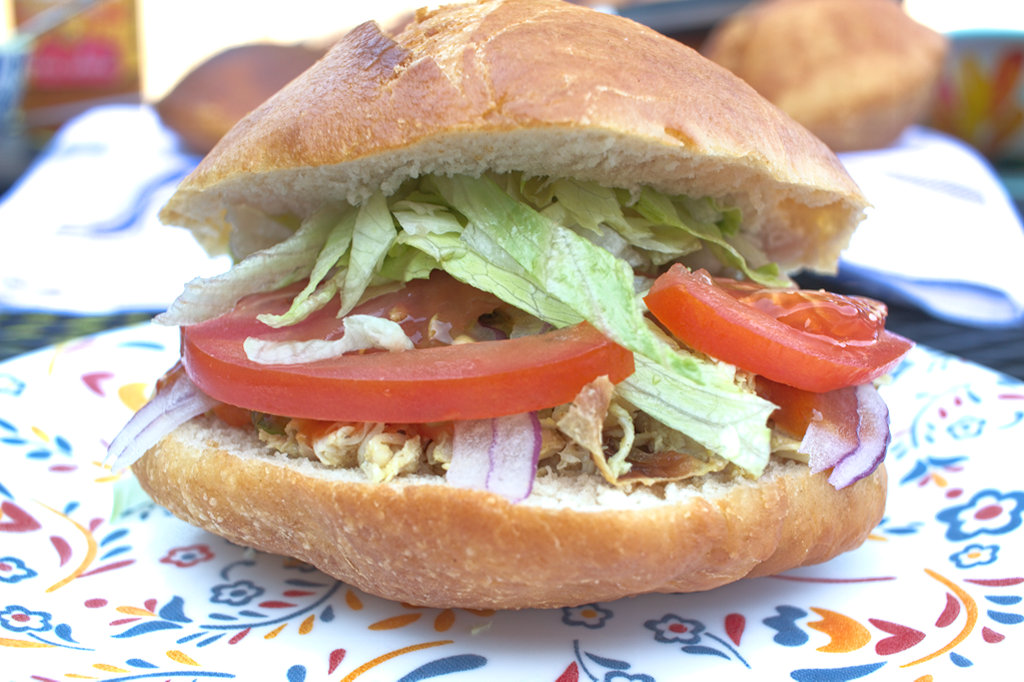Simit-Poğaça? No, Simit-Pogača!
A number of linguistic, social, and geopolitical confusions surround this month’s Simit-Pogača sandwich, making it not only difficult to research, but problematic to discuss once the research is complete. A brief historical digression, as we have the occasional tendency to do here at the Tribunal, may be helpful to untangle both.
The Turkish language is a fertile source of loanwords to other tongues. Even here, on the other side of the world, 5473 miles and eight time zones from Istanbul, there are a number of words that I use regularly in American English that likely originated in Turkish. Yogurt. Pastrami. Kebab. Yes, they’re all food words–I talk about food a lot. In Southeastern Europe, the fallout from centuries of Ottoman Empire occupation (and decades of the Austro-Hungarian Empire after that over some of that area) has peppered not only the languages of Balkan nations with terms from the Turkish, but their cultures as well.
The south Slavic states that formerly made up Yugoslavia–Slovenia, Croatia, Bosnia-Herzegovina, Serbia, Montenegro, Albania, and Macedonia–are among those former Ottoman Empire territories, though mostly not Austro-Hungarian. Culinarily and culturally, they share many touchstones with Turkey. The state labeled Macedonia (see Yugoslavia map above) is part of a larger geographical area called Macedonia spanning multiple nations. From the breakup of Yugoslavia in 1991 until 2019, this state was called the Republic of Macedonia. Greece, which also contains a sizable portion of the historical region called Macedonia (split into administrative regions Western Macedonia, Central Macedonia and Thrace, and Eastern Macedonia), objected to the unqualified use of “Macedonia” by their neighboring nation. An agreement was reached between the two countries and Macedonia became the Republic of North Macedonia.
Many still use Macedonia as shorthand for the name of the country, out of habit, or out of preference. Some Greeks object to this, feeling strongly that historically, the Macedon of Alexander was a Hellenic culture, its Macedonian people Hellenes. Macedonians, ethnically a Slavic people, resent the Greek attempt at erasure of their identity. Accusations of cultural insensitivity may answer any use of either the politically accurate North Macedonia (satisfying the Greeks, but upsetting the Macedonians) or the familiar and common Macedonia (which angers the Greeks while appeasing the Macedonians).
In any case, today’s sandwich is served mostly in the city of Skopje, capital of the Republic of North Macedonia (Macedonia to its friends), and is called simit-pogača. According to my Macedonian friend Vasil, it is a “Skopje special of mixing two different things into one,” those things being a bread roll called simit and a pastry called pogača.
In Turkey, and in many areas of the former Ottoman Empire, there is a kind of bread product called simit. Turkey also has a kind of stuffed pastry-like bread called poğaça. In addition to those, a kind of hybrid product has developed called simit-poğaça. All over the Balkan world, there are various bread products called pogača, a cognate to the Italian word focaccia meaning “hearth bread.” It might be a biscuit or a soft bread, leavened or unleavened, stuffed or unstuffed, or a kind of laminated dough, like a puff pastry or phyllo, that is a widespread variant called pogačice. Researching simit is relatively easy. Researching pogača is more challenging–pay close attention to those diacritics! Information about the hybrid form is also difficult to parse from writeups of the much more common Turkish item with the confusingly similar name.
Nominally, we are writing about the Macedonian simit-pogača rather than the Turkish simit-poğaça. But… why not both?
Turkish Simit-Poğaça
Mindy and I went to a Turkish cafe we enjoy, Istanbul Market in Mount Prospect, to try their renditions of the Turkish baked goods, if only to be able to properly differentiate them from the Macedonian versions. While there, we also enjoyed a dish of hummus as well as lahmacun, a spicy meat-topped flatbread served with onions, tomatoes, parsley, and lemon for garnishing, and their doner kebab, thin-sliced beef with tomatoes, parsley, and lettuce, rolled up in a lavash.


We were there, though, to learn about simit, poğaça, and hopefully simit-poğaça. Simit, sometimes called Turkish bagels, are ring-shaped breads festooned with sesame seeds, rigid-crusted but with a soft, chewy crumb. They are quite good on their own, but also excellent with cheeses, or for dipping into Istanbul Market’s well-seasoned hummus.

Their poğaça are much softer, almost cake-like, a pastry stuffed with a thin layer of feta cheese and topped by a smattering of sesame seeds lacquered to the surface by means of some browning agent.

Turkish simit-poğaça, on the other hand, are a hybrid of the two forms–a bread roll rather than a pastry, coated abundantly in sesame seeds and stuffed with some savory filling–feta cheese, or kashkaval, or a seasoned meat mixture perhaps.
Istanbul Market carried them in the freezer, but I opted to make my own, using the method described in the above video. The only alterations to that recipe that I made were 1), to add a handful of chopped parsley to the feta cheese filling, and 2) to replace grape molasses, which I could not find, with pomegranate molasses.

The rolls are delicious, with a crust and crumb much like the simit we had at Istanbul Market, but a generous filling of briny, herby feta and parsley filling

I very much enjoyed these Simit-Poğaça. They are not, however, the Simit-Pogača we are looking for.
Macedonian Simit-Pogača
The Macedonian simit rolls are similar in shape and look to the Turkish simit-poğaça–larger, less fully coated in sesame seeds, and of course without the cheese-and-herb filling. Yet very much the same regardless–good bread in a soft chewy roll. Without the full coating of sesame seeds the crust is less rigid, but it is good bread.

The flaky pogačice pastry is challenging to make. The dough must be mixed together and kneaded, split into several small balls, and rested to allow the glutens to relax. Then it is rolled out, coated with melted butter or oil, and hand-stretched to translucent thinness. This very thin dough is again brushed with melted butter or oil, folded over several times to the size and shape of the pan it will be baked in, and added to the pan. The process is repeated for each of the balls of dough until a pastry of 12-20 layers or more is formed. The pastry is baked, brushed with more butter, and seasoned with salt before being cut into rectangular or rhomboid pieces of a size to fit the rolls.

Simit-Pogača is served as a street food in Skopje, for breakfast mainly served with a bowl of yogurt, or perhaps a glass of soured milk, a type of yogurt-like beverage.

A beverage is needed, as this is among the most carb-on-carby of sandwiches. Though the roll is good, soft and warm and toasty from the sesame seeds, and the pastry is also delicious, salty and fatty, crisp-edged and flaky and a little soft on the inside, the combination of the two can still tend a little toward the dry.

Why just the unfilled pogačice? Why not a zelnik or maznik or burek, bursting with hot eggy spinach and cheese or onion-studded ground beef? Perhaps someone in Skopje knows the answer, but the internet has not been forthcoming.

My own idiot curiosity aside though, it doesn’t really matter. If the sandwich were more broadly appealing it might be more broadly adopted, but this is Skopje’s sandwich and their tastes are their own. Context is king–perhaps one day I can try one in the Macedonian capital city itself.

I like sandwiches.
I like a lot of other things too but sandwiches are pretty great














Recent Comments